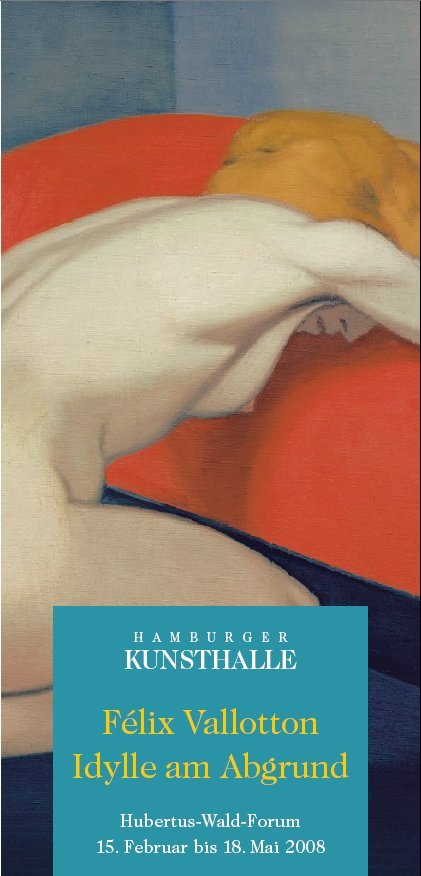Felix Vallotton
dal 14/2/2008 al 17/5/2008
Segnalato da
14/2/2008
Felix Vallotton
Hamburger Kunsthalle, Hamburg
Idyll on the Edge. The work of this detached observer of bourgeois double standards, whose art contained elements that would later feature prominently in Surrealism, New Objectivity and Metaphysical Painting. The show brings together more than 70 paintings and over 50 woodcuts, as well as posters, books, and vignettes designed by this fascinating artist of the early 20th century.

Fondation Félix Vallotton
Curator of the exhibition: Dr. Felix Krämer
Assistant: Dr. Dorothee Gerkens
Bizarre poses, bashful embraces, silent interiors and revealing shadows – Félix Vallotton’s art is imbued with a biting sarcasm and black humour that established him as an internationally acclaimed avant-garde artist of the modern period. His images are disturbing, revealing and captivating – now just as much as in 1909, when young people were refused admission to his first solo exhibition at the Kunsthaus Zürich because the nude paintings were deemed too shocking. From 15 February to 18 May 2008, the Hamburger Kunsthalle will be showing the work of this detached observer of bourgeois double standards, whose art contained elements that would later feature prominently in Surrealism, New Objectivity and Metaphysical Painting. The exhibition Félix Vallotton. Idyll on the Edge has been organised in cooperation with the Kunsthaus Zürich. It brings together more than 70 paintings and over 50 woodcuts, as well as posters, books, illustrations and vignettes designed by this fascinating but – in Germany at least – largely unknown artist.
Following Vilhelm Hammershøi and Helene Schjerfbeck, the Hamburger Kunsthalle is once again focussing attention on a ‘known unknown’ artist of the early 20th century who is definitely worth rediscovering. Félix Vallotton (1865–1925) wasn’t a particularly likeable character, however – friends and colleagues described him as reserved and tight-lipped. Vallotton was a loner whose diaries often contained scornful remarks about his fellow human beings: “The life I live is literally the opposite of the life I dreamed of. I love seclusion, silence, cultivated thinking and reasoned action – and I have to deal with machinations, foolish talk and vain affectation.”
At first glance, Vallotton’s art seems cool and controlled, its deceptive, hermetically sealed surfaces concealing the depths beneath. Even more so than in his paintings, this ambiguity is particularly apparent in Vallotton’s finely executed prints, which were held in such high esteem by his contemporaries that little attention was paid to his paintings. This exhibition at the Hamburger Kunsthalle presents more than 50 woodcuts that clearly demonstrate his sharply critical, ironic gaze. Beneath the cleanly executed blackandwhite of his woodcuts lies an intricate web of suspicion, oppression, constraint and fear. The humour is decidedly black, with the result that the viewer’s scornful laughter often gets stuck in their throat.
Born in Lausanne in 1865, Vallotton (1865–1925) studied in Paris and became closely associated with the Nabis artists’ group, which also included Edouard Vuillard and Pierre Bonnard. Vallotton worked as an illustrator and journalist, and also wrote plays which – like his paintings – were highly provocative and critical of bourgeois conventions. He lived in Paris during the Belle Époque – a society oscillating between the poles of decadent spectacle and severe economic depression. Having risen to the ranks of the bourgeoisie through marriage, he then turned his unsparing gaze on the double standards of the Parisian bourgeoisie, the raging battle of the sexes and the new self-assurance of women. In his paintings and prints he exposes his protagonists by placing them in carefully constructed, stage-like settings.
Vallotton’s nudes and interiors depict scenes of exposure and adultery, concealed by heavy curtains and surrounded by knickknacks and cheap ornaments; his protagonists are caught up in a tightly woven net of betrayal and oppression. In stylistic terms, it is above all the artificiality of his subjects that makes his works so unsettling: still lifes characterised by fields of intense colour, empty landscapes defined by bold chiaroscuro, and portraits painted with uncustomary harshness.
In their veiled eroticism and starkly realistic style of painting, Vallotton’s nudes are surprisingly modern.
For his contemporaries, Vallotton’s open depiction of the conflict between human desire and moral codes, his complex atmospheric weave of distance and proximity, often overstepped the boundaries of acceptability. He surveyed his naked models in an almost psychoanalytic manner, portraying them realistically – and sometimes unflatteringly – with a slight squint, unevenly shaped breasts or a low hairline. In 1936, the collector Hedy Hahnloser-Bühler commented upon Vallotton’s portraiture: “Nobody was keen to be dissected by that unrelenting eye, so careful not to leave any physical or moral blemish unseen.”
Vallotton remained one of the leading figures of Symbolism until his death in 1925. Members of the Brücke group above all were influenced by his prints in their use of woodcut, while his figurative, strangely detached paintings inspired the artists of the New Objectivity movement. Vallotton’s visual language is also echoed in Surrealism, Pittura Metafisca or Pop Art. To this day, his oeuvre with its sustained inner tension remains a decisive point of reference for artists. It is not surprising, therefore, that Daniel Richter, whose own vibrantly coloured work contains nightmarish scenes that seems to have sprung from Vallotton’s dark imagination, describes Félix Valloton as “the idol of my sleepless nights”.
A comprehensive catalogue has been published to accompany the exhibition, available from the museum shop for EUR 35. An audio guide tour of the exhibition in German or English can be rented for EUR 3.
The exhibition was made possible by the Hubertus Wald Stiftung Hamburg.
Press office
Alexandra Pioch
T +49 (0)40 428131217 F +49 (0)40 428542978 pioch@hamburger-kunsthalle.de
Hamburger Kunsthalle
Glockengießerwall · D-20095 Hamburg
Opening hours
Tuesday to Sunday 10 a.m. to 6 p.m.,
Thursday 10 a.m. to 9 p.m., closed on Monday
Admission prices
Adults: 8,50 €, concessions: 5 €, family
ticket: 14 €, children and young person until 18 free of charge



